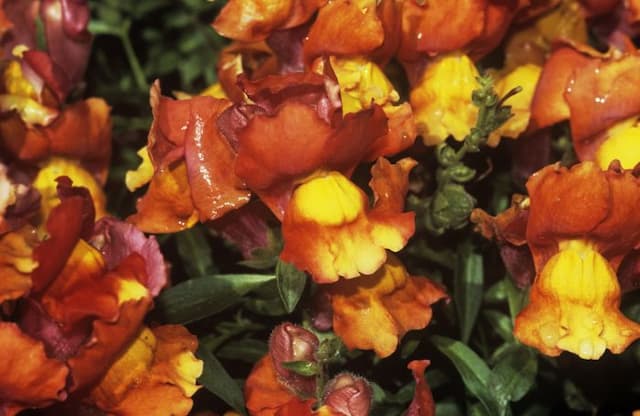Foxglove Digitalis purpurea subsp. heywoodii 'Silver Fox'

ABOUT
'Silver Fox' is a variety of the common foxglove, recognized for its striking appearance. This plant typically has a basal rosette of leaves from which stems arise. The leaves at the base are large, oval, and hairy, with a silvery-grey color that gives the plant its name 'Silver Fox'. The texture of the leaves is soft due to the fine hairs, giving them a velvety feel. This cultivar is specifically appreciated for its foliage color as much as for its flowers. The flowers are arranged in a tall, one-sided spike and are tubular with a slight bell shape. They come in shades of pink to purple and are often speckled with darker spots inside the throat of the bloom. These spots are thought to act as guides for pollinating insects. The flowers are delicate and pendulous, providing a beautiful contrast against the silver foliage. The overall impression of 'Silver Fox' is one of a decorative and elegant plant with a distinctive color palette of silvery foliage and soft pink to purple flowers. It has a whimsical and somewhat romantic presence in the garden due to its tall flower spikes and striking leaf coloration.
About this plant
 Names
NamesSynonyms
Common Foxglove, Purple Foxglove, Lady's Glove, Fairy Gloves
Common names
Digitalis purpurea subsp. heywoodii 'Silver Fox'.
 Characteristics
CharacteristicsLife cycle
Biennials
Foliage type
Semi-deciduous
Color of leaves
Green
Flower color
Pink
Height
2 feet (0.61 meters)
Spread
1 foot (0.30 meters)
Plant type
Herb
Hardiness zones
5
Native area
Europe
Benefits
 General Benefits
General Benefits- Attracts Pollinators: 'Silver Fox' attracts bees and hummingbirds, which are important for pollination.
- Ornamental Value: With its unique silver-green foliage and pink to purple flowers, Digitalis purpurea subsp. heywoodii 'Silver Fox' adds aesthetic value to gardens.
- Habitat Support: It provides habitat and food for various insects and birds in the ecosystem.
- Drought Tolerance: Once established, it exhibits a good level of drought tolerance, meaning it requires less frequent watering.
- Low Maintenance: This plant does not require extensive care, making it a good choice for low-maintenance landscapes.
- Erosion Control: It can help in stabilizing soil and preventing erosion in certain areas.
 Medical Properties
Medical Properties- Cardiac stimulant: Digitalis, the active compound in foxglove, increases the force of myocardial contractions, thereby treating heart failure.
- Antiarrhythmic agent: It can help in correcting irregular heartbeats.
 Air-purifying Qualities
Air-purifying QualitiesThis plant is not specifically known for air purifying qualities.
 Other Uses
Other Uses- Photography: The attractive, silver-frosted leaves of the Digitalis purpurea, commonly known as Foxglove, can be used in macro photography to create artistic images due to their unique texture.
- Textile Dyes: Historically, Foxgloves have been used to produce various colored dyes, which could be applied to natural fibers in textile work to produce unique hues.
- Protective Plantings: Foxgloves can be planted around gardens that are frequently visited by deer since they tend to avoid these plants, providing a natural form of protection for more susceptible flowers and vegetables.
- Fairy Gardens: Due to their whimsical shape and historical association with fairies, these plants are perfect for creating 'fairy garden' designs to enchant children.
- Teaching Tool: Foxglove flowers can be used in educational settings to teach students about plant biology, pollination, and the importance of bees in the ecosystem.
- Musical Inspiration: The distinctive bells of the Foxglove can inspire musicians and composers looking for natural forms to incorporate into their creative work.
- Culinary Decoration: While the plant itself is not edible, the blossoms can be used to add decorative elements to cakes or dishes, provided they are removed before consumption due to their toxicity.
- Painting: The rich colors and form of Foxglove flowers make them excellent subjects for watercolor or botanical painting workshops.
- Witchcraft and Spellcraft: In some traditions of witchcraft, parts of the Foxglove plant are used symbolically within spells and rituals, especially those associated with protection and vision.
- Perfumery: Although not commonly used due to their toxicity, Foxgloves can theoretically be used in the perfumery industry to capture their scent profile for creating botanical essences.
Interesting Facts
 Feng Shui
Feng ShuiFoxglove is not used in Feng Shui practice.
 Zodiac Sign Compitability
Zodiac Sign CompitabilityFoxglove is not used in astrology practice.
 Plant Symbolism
Plant Symbolism- Healing: Commonly known as Foxglove, Digitalis purpurea has been used medicinally to create digitalis, a group of drugs that can treat heart conditions, symbolizing healing and protection.
- Bewitchment and Magic: With its association with folklore and its striking appearance, the Foxglove often represents enchantment and the idea of penetrating the veil between the mundane and the magical.
- Insincerity: In the language of flowers, Foxglove can sometimes symbolize insincerity or a false sense of security, possibly because of its toxic properties and the duality between its medicinal and poisonous aspects.
 Water
WaterFor the Foxglove 'Silver Fox', water the plant when the top inch of soil feels dry to the touch, which typically equates to watering once a week. However, in hot, dry conditions, it may require watering twice a week. Use a watering can to gently soak the soil around the base of the plant, avoiding wetting the foliage to prevent disease. Foxgloves prefer consistently moist soil, so aim to provide about one gallon of water for each plant during the weekly watering, adjusting as necessary for weather conditions.
 Light
LightFoxglove 'Silver Fox' thrives best in partial shade to full sun conditions, where it can receive four to six hours of sunlight each day. It is ideal to plant it in a spot that is sheltered from the harsh afternoon sun, especially in warmer climates, to prevent the foliage from scorching.
 Temperature
TemperatureFoxglove 'Silver Fox' grows optimally in a temperature range of 60 to 80 degrees Fahrenheit. It can tolerate minimum temperatures down to 40 degrees Fahrenheit and maximum temperatures of up to 90 degrees Fahrenheit, but prolonged exposure outside this range may harm the plant.
 Pruning
PruningPrune Foxglove 'Silver Fox' after blooming by deadheading the spent flower spikes to encourage a second bloom and to prevent excessive self-seeding. Prune again in late fall to remove dead or yellowing leaves. The best time for major pruning is in early spring, trimming back any frost-damaged foliage.
 Cleaning
CleaningAs needed
 Soil
SoilFoxglove 'Silver Fox' thrives in a moist, well-draining soil mix, rich in organic matter. For the best growth, the soil should have a slightly acidic to neutral pH, between 5.5 to 7. A mix of loam, peat or leaf mold, and coarse sand or perlite can create an ideal environment for this plant's roots.
 Repotting
RepottingFoxglove 'Silver Fox' typically does not require frequent repotting as it is a biennial plant. It should only be repotted if the soil becomes poor or the plant has outgrown its current container, which might happen every 2-3 years.
 Humidity & Misting
Humidity & MistingFoxglove 'Silver Fox' is a plant that prefers moderate ambient humidity levels, but it is quite adaptable and does not require specific humidity adjustments, which makes it relatively easy to grow in a variety of indoor environments.
 Suitable locations
Suitable locationsIndoor
Place in bright indirect light, keep soil moist.
Outdoor
Partial shade, sheltered location, enriched soil.
Hardiness zone
4-9 USDA
 Life cycle
Life cycleDigitalis purpurea subsp. heywoodii 'Silver Fox', commonly known as Foxglove 'Silver Fox', begins its life as a seed that typically germinates in spring after experiencing a period of cold stratification. The seedlings develop into a rosette of silver-gray leaves in the first year, which is the vegetative stage of the plant. In the second year, Foxglove 'Silver Fox' progresses to the reproductive stage, sending up tall flower spikes adorned with bell-shaped, tubular flowers that range from pale pink to purple, with spotted throats. These flowers are pollinated by bees, after which the plant produces capsule-like fruits that release numerous tiny seeds. Once seed dispersal occurs, the biennial plant typically dies, having completed its two-year life cycle. However, if conditions are favorable, Foxglove 'Silver Fox' may behave as a short-lived perennial, regenerating from the basal foliage to flower in subsequent years.
 Propogation
PropogationPropogation time
Spring to early summer
Propogation: The common foxglove, Digitalis purpurea subsp. heywoodii 'Silver Fox', is typically propagated through seed sowing. The most suitable time to sow foxglove seeds is late spring to early summer, ensuring that the temperature is mild and not excessively hot, as extreme heat can hinder germination. Sowing seeds directly into the soil where the plants are to grow is a straightforward approach. The seeds should be sown very thinly on the surface of a well-drained seed compost, and lightly covered with a thin layer of compost or vermiculite. They require light for germination, so it’s crucial not to bury the seeds too deeply. Maintain a consistent level of moisture without overwatering, and expect germination in approximately 2 to 3 weeks. Once seedlings are large enough to handle, they can be transplanted to their final position in the garden, spacing them about 12 to 18 inches (30 to 45 centimeters) apart to accommodate growth.









